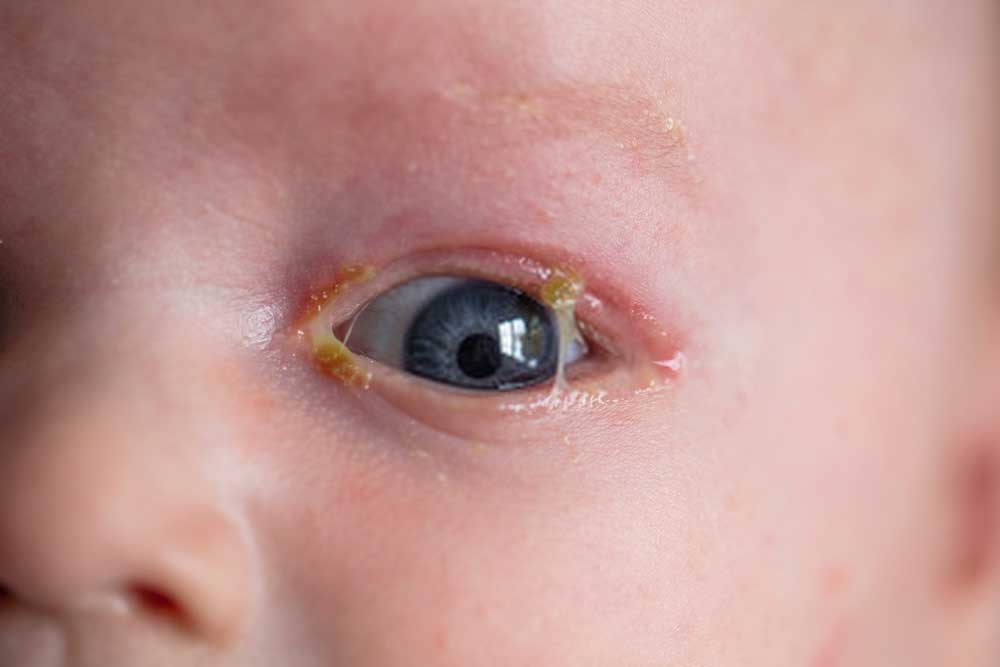Newborns have many unique features that leave parents wondering why their little one looks like they do. One common feature is the crusty and gooey appearance of newborns’ eyes. This phenomenon is known as neonatal conjunctivitis, or more commonly, “sleepy eyes.” So why do newborn eyes get crusty?
The most likely cause of sleepy eyes in a newborn is a type of bacteria called Neisseria gonorrhoeae, which can be passed from mother to baby during delivery. The bacteria causes an eye lining infection that leads to irritation, redness, and swelling. This bacterial infection is known as ophthalmia neonatorum and can lead to vision problems if left untreated.
What causes eye discharge (crusty eyes) in newborns?
Having a newborn can be daunting for many new parents, especially regarding their health. One common issue new parents face is eye discharge in their newborn babies. This condition causes to eyes get crusty, often accompanied by redness and itchiness.
The most common cause of eye discharge (eyes get crusty) in newborns has to do with blocked tear ducts. These occur when the tiny openings that allow tears to drain from the eyes become clogged with mucus or other debris.
In most cases, this blockage resolves itself within 12 months of birth without any medical intervention. However, if the problem persists or there are any concerns about your baby’s health, it is essential to seek professional advice from a pediatrician or an ophthalmologist as soon as possible.
Blocked tear ducts:
Blocked tear ducts are a common eye condition affecting children and adults. The most noticeable symptom of blocked tear ducts is that eyes get crusty with dried tears, which can cause discomfort and irritation. In addition, patients may experience excessive tearing or watery eyes, redness in the inner corners of the eyes, swollen lids, or recurrent infections of the eyelid area.
Tear duct blockages can occur due to an obstruction in the tear drainage system or inflammation from a bacterial infection.
Depending on the cause, treatment for blocked tear ducts may involve antibiotics for infections, massage techniques to help unblock clogged glands, and surgery if necessary. It is essential to consult your doctor if you have any signs or symptoms associated with blocked tear ducts so they can provide you with an accurate diagnosis and appropriate treatment plan.
Chemical conjunctivitis:
Chemical conjunctivitis is an irritation of the eyes caused by exposure to foreign substances, such as chlorine, from swimming pools. It typically results in redness and swelling of the eyes and a gritty or burning sensation. In some cases, chemical conjunctivitis can cause a person’s eyelids to become swollen and their eyes get crusty.
The most common causes of chemical conjunctivitis are fumes from smoke or aerosol sprays, soot particles, health care products like eye drops or contact lens solutions, and industrial chemicals like solvents or degreasers. It can also be caused by chlorine in swimming pools or hot tubs containing too much-chlorinated water. Exposure to these irritants triggers inflammation in the eyes and leads to symptoms of chemical conjunctivitis.
Neonatal conjunctivitis (pink eye):
Neonatal conjunctivitis, commonly known as pink eye, is an eye infection affecting newborn babies. It can be caused by a virus, bacteria, or an allergic reaction and is one of the infants’ most common eye infections. This condition typically begins within the first two weeks after birth and can cause discomfort in the baby’s eyes as they get red and swollen.
Symptoms include watery or mucous discharge from eyes that may be clear, yellowish-green, or have blood in it; eyes get crusty from drying discharge; eyelids can become inflamed; sensitivity to light; and sometimes coughing and fever. Treatment for neonatal conjunctivitis depends on what type of infection the baby has and typically includes antibiotic eye drops or ointment to clear up any bacterial infections quickly.
Ophthalmia neonatorum:
Ophthalmia neonatorum (ON) is an eye infection that can affect newborns. ON is caused by bacteria entering the baby’s eyes during delivery and can be called “crusty eye.” Parents need to be familiar with the signs and symptoms of this condition so they can quickly seek medical attention if needed.
Babies with ON may experience symptoms, including redness, swelling, pus, and crustiness around their eyes. Additionally, the eyelids may become stuck together due to thick discharge from the looks. Other complications from ON include corneal ulcers or clouded vision, which can lead to permanent blindness if left untreated.
Newborns need to receive proper care and treatment to prevent any long-term damage that could have been caused by ophthalmia neonatorum.
Blocked tear ducts cause crusty eyes:
Do you often notice your eyes getting crusty? This common symptom may be the result of blocked tear ducts. Blocked tear ducts are surprisingly common, and children and adults can suffer from them. In most cases, these tears can get blocked due to an infection near the eyelids or structural abnormalities. When this happens, it is difficult for tears to properly drain away from the eye leading to irritation and crusting around the eyelid area.
Fortunately, some steps can be taken to help alleviate this condition, such as using artificial tears or topical antibiotics prescribed by your doctor. If that doesn’t work, there are even more invasive treatments like probing, which involves using a thin metal instrument inserted into the tear duct opening to open it up and allow tears to flow more freely again.
How to identify?
No one wants to wake up in the morning with crusty eyes. Not only is it uncomfortable, but it can be a sign of an underlying health issue. But how do you identify if your eyes are just irritated or if there is something more serious? Here are some tips on identifying when your eyes get crusty and what steps you should take next.
First, take note of any other symptoms that occur along with the crustiness in your eyes. Is your vision blurry? Is there redness or swelling around the eye area? These could indicate more severe problems such as an infection or allergy. If you notice any other symptoms, make sure to seek medical attention right away.
Next, consider what may have irritated your eyes in the first place – was it dry air? Could you have rubbed them too hard while washing them?
Normal or not:
Normal or not? Is it normal for eyes to get crusty from time to time? It can be disconcerting when you notice that your eyes get crusty, but it is pretty standard. In most cases, there are simple explanations for why your eyes might become crusted over with sleep or other environmental elements.
The most common cause of crusty eyes is the natural process of tear production and evaporation. As tears evaporate, they form a thin film on the surface of your eye, which can eventually harden into a thicker layer.
Other causes could include allergies, infection, dry eye syndrome, or even medications that cause dryness in the eyes. If your eye crustiness persists despite artificial tears and other treatments, then seeing an optometrist may be necessary to determine if something is more underlying.
Treatment:
Many people suffer from an eye condition that causes their eyes to get crusty and become dry and itchy. This condition is known as blepharitis and can be uncomfortable and troublesome. Fortunately, various treatments are available for those who suffer from this common ailment.
The most common treatment for blepharitis is eyelid hygiene. This involves gently cleansing the lid margins with warm compresses or a mild soap solution several times daily. Additionally, using artificial tears or lubricating ointments may be recommended throughout the day to keep the eyes moist and minimize crusting. In more severe cases of blepharitis, a doctor may prescribe antibiotics or steroid drops to reduce inflammation around the eye area.
Ointments or eye drops cause crusty eyes:
Many people suffer from eyes that get crusty, a condition known as conjunctivitis. Conjunctivitis is generally caused by either an infection or an allergic reaction and can cause redness, swelling, itching, and increased production of tears. In some cases, ointments or eye drops may also lead to crusty eyes.
When treating this issue with medications like ointments and eye drops, people should always check with their doctor first to ensure they are using the right type for their condition. If not used correctly, these medications can cause more irritation, leading to more crustiness around the eyes. It’s essential to follow directions when using such drugs and only use them for as long as prescribed by your doctor.
How to identify?
If your eyes get crusty, it may be a sign that something is wrong. Identifying the source of this issue can help you get the appropriate treatment and ensure your vision remains healthy.
It is essential to know what factors can cause eyes to become crusty so you can take steps to address them. Dust and dirt, allergies, eye infections, dry eye syndrome, blepharitis, and conjunctivitis are all potential causes of this symptom.
If your eyes have been getting increasingly crusty recently, or if you experience any other symptoms, such as redness or pain in the area around your eyes, it’s best to see an optometrist or ophthalmologist right away for an evaluation. They can diagnose the cause of your condition and provide the best course of treatment for restoring clear vision and proper eye health.
Normal or not:
Expected or not – Do your eyes get crusty?
We’ve all experienced the occasional morning when our eyes feel heavy, have difficulty opening, and feel as if they are glued shut. The source of this uncomfortable feeling is often due to a buildup of oil, debris, and mucus in the corners of our eyes overnight. This can cause them to become crusty when we wake up.
In most cases, mild crustiness around the eyes will clear up on its own during the day with no need for treatment. If it persists, however, it can be a sign of an underlying issue such as allergies or an infection. It is important to note that if you experience any other symptoms along with your eye crustiness, such as redness, pain, or discharge, this could indicate something more severe. You should seek medical attention immediately.
Treatment:
For many people, waking up with crusty eyes can be a challenging experience. It is uncomfortable and can lead to further irritation if not treated properly. Luckily, several ways exist to help treat these symptoms and relieve discomfort.
The first step in treating crusty eyes is to determine why they may be happening in the first place. Common causes include allergies, inadequate sleep, or environmental factors like air pollution or dust particles.
Once the underlying cause has been identified, it’s time to take action and find ways to ease any eye pain or discomfort associated with this condition.
Crusty eyes are caused by pink eye:
Crusty eyes are a concerning symptom of pink eye, or conjunctivitis, an inflammation of the thin membrane covering the white part of your eyes and inside your eyelids. If you have crusty eyes and suspect that you may have pink eye, it’s essential to get treatment from a medical professional as soon as possible.
The main symptom of pink eye is when one or both eyes become red and watery, with a burning sensation. Along with this, the affected area will likely become swollen and itchy.
In addition to these symptoms, some people with pink eye report having their eyes get crusty over time – especially overnight – due to discharge from the affected areas. The crust can be quite uncomfortable and irritating on its own if left untreated.
How to identify
Eyes getting crusty can be a sign of an underlying eye condition. It’s essential to identify the cause so it can be adequately treated. To help determine the source of your eye issues, here are some tips on identifying whether eyes getting crusty is a common symptom or something more serious.
The most obvious way to tell if something is wrong with your eyes is by looking in the mirror and noticing any signs of irritation or redness around the eyelids or whites of your eyes. In addition, pay attention to any discharge from your eyes, such as a watery or thick pus-like substance that may have an unpleasant smell or color and could indicate infection.
Normal or not:
Do you ever wake up in the morning with eyes that feel crusty and dry? It’s common for many people, but it can be uncomfortable and even painful. If this happens to you regularly, then it’s essential to determine why your eyes get crusty.
The most common cause of crusty eyes is an underlying medical condition such as dry eye syndrome or blepharitis. Dry eye syndrome occurs when your eyes don’t produce enough tears, while blepharitis is an inflammation of the eyelids that causes redness and itching. Other possible causes include the following:
- Allergies.
- Hormonal changes during menopause.
- Environmental factors like smoke inhalation.
- Living in a dry climate.
- Using contact lenses for long periods without giving your eyes a break.
Treatment:
The symptoms can often be uncomfortable and irritating for those who suffer from dry eyes. Symptoms of dry eyes include a burning sensation, redness, light sensitivity, and crusty eyelids. Treating these eye issues can help reduce some of the discomfort associated with them.
Treatment for dry eyes should begin with lifestyle changes. Avoid staring at screens for long periods without breaks and limit exposure to smoke or wind, which can lead to further irritation. Additionally, artificial daily tears can help keep the eyes moistened and lubricated.
Suppose natural remedies are not enough to provide relief. In that case, a doctor may suggest ointment or drops that contain prescription-strength ingredients such as steroids or antibiotics to alleviate inflammation or bacterial infections causing the issue. In extreme cases of dry eye syndrome, surgery may be necessary to restore tear production.
Crusty eyes caused by an infection:
Are your eyes feeling crusty and uncomfortable? It’s possible that you may have an infection. A crusty look is a common symptom of many diseases, such as bacterial or viral conjunctivitis. This condition is also known as “pink eye” because it causes redness and swelling around the eyes. Other symptoms include watery discharge, itching, burning sensations, and sensitivity to light. Proper diagnosis and treatment can help alleviate these bothersome symptoms quickly and effectively.
If you experience any of these signs or symptoms, seek immediate medical attention so your doctor can properly diagnose the underlying cause of your crusty eyes. Depending on the type of infection, your doctor may prescribe antibiotics or antiviral medications to treat it.
How to identify?
A crusty eye can indicate a severe medical condition, so it is essential to know how to identify this symptom.
The first sign of having crusty eyes is the presence of thick discharge in or around one’s eyes. This discharge may be yellow, green, or white and could have a strong odor. In some cases, the release may cause the eyelids to stick together when waking up in the morning. Other signs include:
- Redness and swelling around one’s eyes.
- Excessive tearing.
- Itchiness.
- Feeling as if something is stuck in their eye.
It is essential for anyone who notices these symptoms to schedule an appointment with their doctor immediately for further assessment and treatment options. Your doctor can provide information about potential causes and treatments for your condition that are explicitly tailored to your needs.
Normal or not:
When it comes to the health of our eyes, most people understand that there is a baseline of normalcy. We know that an occasional red eye, or a feeling of dryness, is expected. However, what happens when your eyes begin to form crusty deposits? Is this normal?
The truth is that many factors can cause one’s eyes to become crusty and uncomfortable. These include allergies, irritation from contact lenses, or even colds and viruses. In some cases, the issue may be more severe and require medical attention; for example, if your eyes are swollen or constantly watery, it may be time to visit a doctor.
In general, if you occasionally experience crustiness around your eyelids, it’s likely nothing to worry about.
Treatment
If you’re suffering from eyes constantly getting crusty, you may wonder what your treatment options are. The good news is that various treatments are available for this condition, so it is essential to evaluate all your options.
The first step in finding the best treatment for your eyes is to see an eye specialist. An ophthalmologist or optometrist can examine your eyes and determine the underlying cause of why eyes get crusty. They can then recommend the right course of action, medication, surgery, or lifestyle changes.
If medication is prescribed, follow all instructions carefully and take any recommended tests as advised by the doctor. Surgery may also be necessary if non-surgical methods have not worked or an underlying medical condition must be addressed.
Conclusion:
Newborn eyes get crusty mainly due to the presence of natural mucus produced by the tear glands in their eyes. This mucus helps protect and lubricate the newborn’s eyes, but it can also accumulate and form a crust.
The buildup of this crust can be easily removed using warm water and cotton swabs. Parents need to have a basic understanding of why newborn eyes get crusty so that they can adequately care for their child’s delicate eyes.
Read more…










